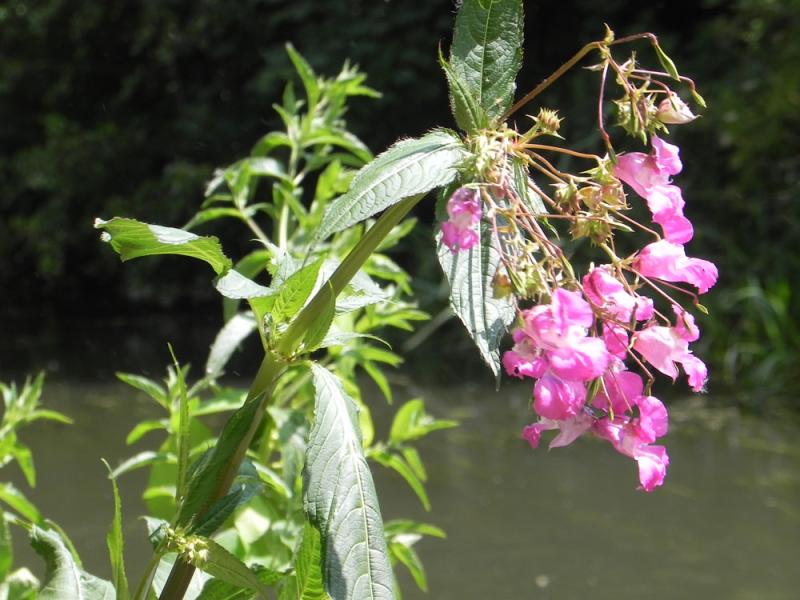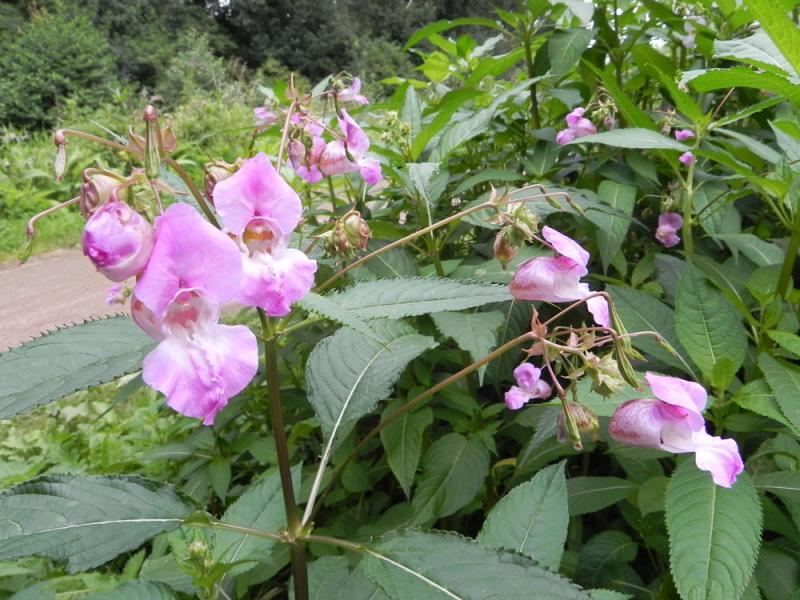For a number of years we have been working to control the spread of Himalayan balsam in the Churnet Valley. Read on to find out why…
This invasive plant (botanical name impatiens glandulifera) was introduced to Britain in the first half of the 19th century by Victorian gardeners. It is the tallest annual plant in the UK, growing to a height of over three metres. Himalayan balsam crowds out native plants and can take over whole areas of river and canal bank. The seeds, up to 800 per plant, are released explosively from the seed pods and can travel for up to seven metres from the plant. If the seeds land in a stream, river or canal they will be taken downstream where they will grow next year, which is one of the reasons why the spread of this plant is difficult to control.
Over the last 20 years this plant has become more established on the canals, rivers and streams of the Churnet Valley. As an annual plant, however, it can be controlled by pulling it up before the seeds develop.
Identification guide:

Flowers
The sweet scented flowers are very attractive to bees, drawing them away from and reducing the pollination of native plants. The flowers appear in June and continue until October. These are purplish pink to very pale pink (almost white) and are slipper shaped on long stalks.
Stems
In the spring the hollow stems are pinky red with green shiny leaves. Himalayan balsam can grow up to 3m tall, combined with the thick foliage this crowds out native plants by reducing sunlight beneath the dense growth.
Seedpods
Seedpods release up to 800 seeds per plant explosively, projecting them to around 7m. Seeds can enter waterways, travel downstream and start a new colony; meaning the plant can spread quickly and over a wide area.

Seeds
The seeds can lie dormant in soil for up to three years making it difficult to eradicate. Therefore, areas being treated should be checked for Himalayan balsam growth annually for at least three years after the last plant is removed.
Leaves
Up to five leaves can grow from each joint and reach up to 5cm long, this creates thick foliage that crowds out native plants by reducing light levels.
Roots
The roots are shallow so do not help much against bank erosion during the growing season; the plant then dies back in winter leaving banks bare and even more susceptible to erosion.
WHAT BOATERS AND WALKERS CAN DO
If you are out for a walk along a waterway this summer, look out for Himalayan balsam, an invasive plant which crowds out native plants and causes problems for wildlife and boating. Whether you are walking the dog or out with family and friends, everyone can help by pulling up a few plants if you see it before the seeds have started to develop.
-
PULL - If you see any Himalayan balsam plants growing, before the seed pods have developed, please pull up the plants (if you can do so safely) – they pull up very easily due to the shallow roots
-
SNAP - Break off the roots below the lowest growing node – this will prevent the plant from re-growing.
- STAMP - Put what you have pulled up into a small pile to rot down, away from the path. Bigger piles can be stamped on to assist the rotting process – small children love doing this and it makes a great sound!
Himalayan balsam is non-toxic, but it is still advisable to wash your hands after carrying out this activity (and before eating) due to potential presence of other plants or Weil’s Disease. Please ensure you don’t accidentally carry the seeds to a new area (e.g. on the bottom of your shoes or on the deck of a boat). To make sure you don’t accidentally spread the plant to new locations it is better not to pull up the plant once the seeds have developed.
Please also report any locations of Himalayan balsam to Recording Invasive Species Counts run by the Botanical Society of the British Isles:
